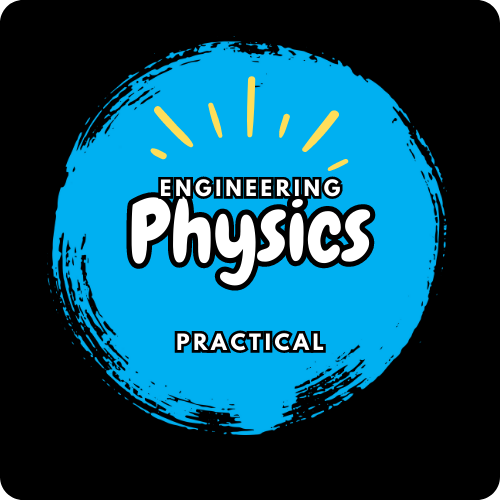Go For Physics Practical
- All Practical List
- All Answers and conclusions
- All Practical in pdf format
- All Practical with Reference YouTube Videos
Engineering Physics Course Plan :
Reference Book :
Unit : 01
Module : 01 Electrostatics & Dielectrics
Coulomb’s law for distribution of charges, Gauss’s law and applications, Electric field intensity, Electric flux, Electric dipole moment, Electric field due to dipole, Introduction to dielectrics, Polarizability, Types of polarization – electronic, ionic, orientational, Polarization of dielectrics, Gauss’s law in presence of dielectric, Dielectric constant, Electric susceptibility and Permittivity, Internal (Local) field in dielectric, Clausius Mossotti equation (with derivation)
Module : 02 Magnetisms
Magnetic field, Steady current, Ampere’s law, Biot-Savart law and its applications, Faradays law of Induction, Lenz’s Law; Effect of magnetic field on current carrying conductor, Lorentz force. Basic important terms and units in Magnetism, Concept and origin of magnetic moment, magnetic susceptibility, Total angular momentum, Diamagnetism, Para magnetism, Ferromagnetism, Ferromagnetism, Anti ferromagnetism, Domain theory of Ferromagnetism, Curie temperature and hysteresis loss.
Unit : 02
Module : 01 Superconductivity
Superconductivity : Zero resistance, Critical temperature, Meissner effect, Critical field, General properties of superconductors, Type-I and Type-II superconductors, BCS theory of Superconductor, High temperature superconductors, Applications of Superconductors: SQUID, Maglev etc.
Module : 02 Sound
Introduction to sound waves, Characteristics and Properties of Sound, Absorption co-efficient, Reverberation time, Sabine’s formula (without derivation), Factors affecting architectural acoustics, Introduction of Ultrasonic waves, Generation of ultrasonic waves, Detection of ultrasonic waves, Applications of Ultrasonic waves: NDT, SONAR & others.
Unit : 03
Module : 01 Quantum Mechanics
Black body radiation: Planck’s law; Wave nature of Particles: De-Broglie theorem, Uncertainty principle; Schrodinger’s wave equation – Time independent and time dependent equations; Born interpretation, probability current; Solution of stationary-state Schrodinger equation for one dimensional problems– particle in a box
Module : 02 Introduction to solids and Semiconductor Physics
Kronig-Penny model (to introduce origin of band gap), Energy bands in solids, E-k diagram; Types of electronic materials: metals, semiconductors, and insulators, Density of states, Occupation probability, Fermi level, Effective mass. Intrinsic and extrinsic semiconductors, Dependence of Fermi level on carrier-concentration and temperature (equilibrium carrier statistics), Carrier generation and recombination, Carrier transport: diffusion and drift, p-n junction diode.
Unit : 04
Module : 01 Wave optics
Huygens’ principle, superposition of waves and interference of light by wave front splitting and amplitude splitting; Young’s double slit experiment, Newton’s rings, Farunhofer diffraction from a single slit, the Rayleigh criterion for limit of resolution and its application to vision; Diffraction gratings and their resolving power, Michelson interferometer
Module : 02 Laser
Einstein’s theory of matter radiation interaction and A and B coefficients; Amplification of light by population inversion, Properties of laser beams: mono-chromaticity, coherence, directionality and brightness; Different types of lasers: gas lasers (He-Ne), solid-state lasers (Neodymium); Applications of lasers in science, engineering and medicine.
